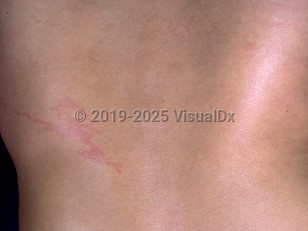Gnathostomiasis
Alerts and Notices
Important News & Links
Synopsis

Gnathostomiasis is a helminth infection contracted after ingesting raw fish, frog, chicken, or pork infected with Gnathostoma spinigerum and other minor Gnathostoma spp.
The cutaneous manifestations are not unlike loiasis, where the patient complains of migratory cutaneous and subcutaneous swellings, which may be amorphous or resemble cutaneous larva migrans (serpiginous). Up to 75% of patients with gnathostomiasis may have cutaneous manifestations. Patients may complain of pruritus, arthralgias and myalgias, fever, nausea, and abdominal pain. Larvae can migrate through any organ and, therefore, nearly any physical symptom is possible; for example, right-upper-quadrant pain and transaminitis may occur as the larvae migrate through the liver. Central nervous system (CNS) disease is rarely reported but carries a markedly worse prognosis (mortality 25%). Marked eosinophilia is common.
Gnathostomiasis is endemic to many parts of Asia and South / Central America and has been described after travel to South and Central Africa. Symptoms (constitutional) occur approximately 2 days to 2 weeks after ingestion of the offending food item, but skin manifestations usually do not begin until 2 weeks or longer after exposure. If left untreated, symptoms may persist for over a decade. Gnathostomiasis occurs more commonly in adults, and there may be a slight male predominance. Recurrence requiring retreatment is not uncommon.
The cutaneous manifestations are not unlike loiasis, where the patient complains of migratory cutaneous and subcutaneous swellings, which may be amorphous or resemble cutaneous larva migrans (serpiginous). Up to 75% of patients with gnathostomiasis may have cutaneous manifestations. Patients may complain of pruritus, arthralgias and myalgias, fever, nausea, and abdominal pain. Larvae can migrate through any organ and, therefore, nearly any physical symptom is possible; for example, right-upper-quadrant pain and transaminitis may occur as the larvae migrate through the liver. Central nervous system (CNS) disease is rarely reported but carries a markedly worse prognosis (mortality 25%). Marked eosinophilia is common.
Gnathostomiasis is endemic to many parts of Asia and South / Central America and has been described after travel to South and Central Africa. Symptoms (constitutional) occur approximately 2 days to 2 weeks after ingestion of the offending food item, but skin manifestations usually do not begin until 2 weeks or longer after exposure. If left untreated, symptoms may persist for over a decade. Gnathostomiasis occurs more commonly in adults, and there may be a slight male predominance. Recurrence requiring retreatment is not uncommon.
Codes
ICD10CM:
B83.1 – Gnathostomiasis
SNOMEDCT:
44086001 – Infection caused by Gnathostoma
B83.1 – Gnathostomiasis
SNOMEDCT:
44086001 – Infection caused by Gnathostoma
Look For
Subscription Required
Diagnostic Pearls
Subscription Required
Differential Diagnosis & Pitfalls

To perform a comparison, select diagnoses from the classic differential
Subscription Required
Best Tests
Subscription Required
Management Pearls
Subscription Required
Therapy
Subscription Required
References
Subscription Required
Last Updated:10/19/2017
Gnathostomiasis

